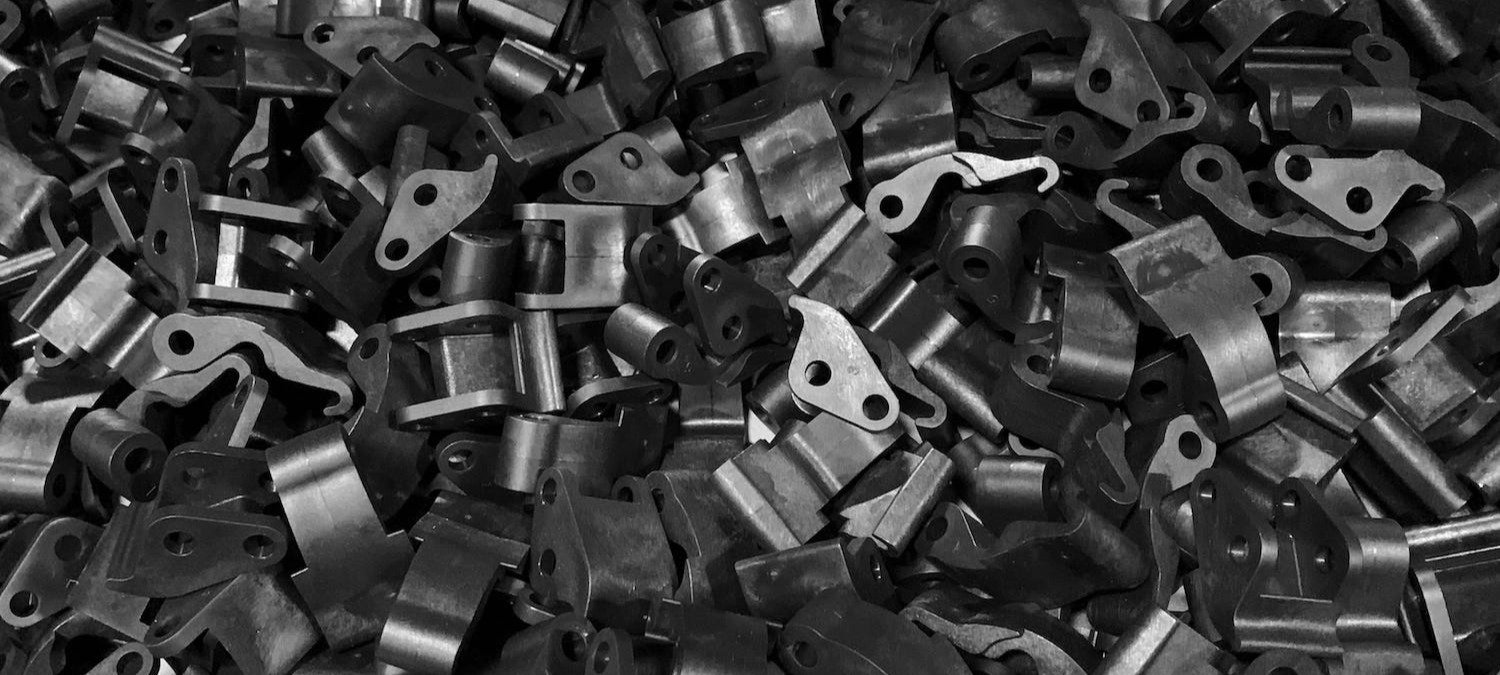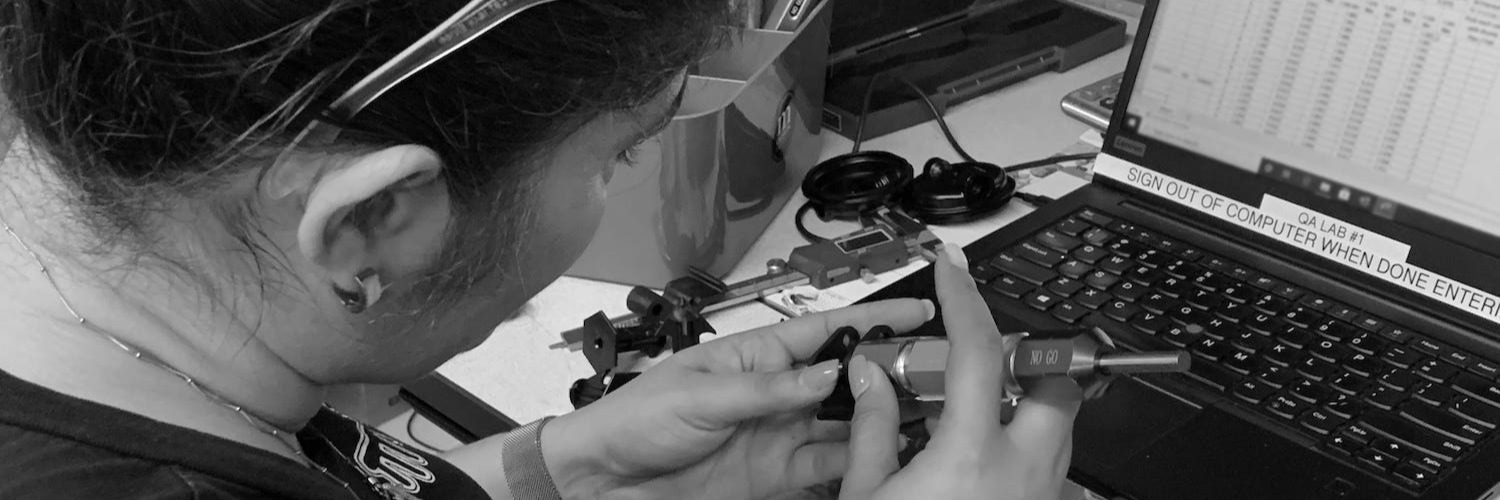Injection molding tooling is a critical component in the plastic manufacturing process, influencing both the quality of your final product and the overall cost of production.
Whether you’re new to plastic injection mold tooling or looking to deepen your understanding, this guide will walk you through the essentials of tooling, its role in the manufacturing process, and what you should consider when looking to work with a new injection molding partner company.
What is Injection Molding Tooling?
Injection molding tooling refers to the molds used in the injection molding process. These molds are precision-engineered tools that shape molten plastic into finished parts. About one-third of plastic production goes into injection molded parts, which makes it the most heavily used production process in the plastic industry. The injection molding process can employ both thermoset and thermoplastic materials (we explain the difference below).
A typical mold consists of two halves – the A-side and the B-side.
The tooling process includes designing and fabricating these molds to ensure they produce parts that meet exact specifications, whether for high-volume production or specialized, complex components.
Why is Tooling Important in Injection Molding?
Tooling is the foundation of successful injection molding. It directly impacts:
-
Product Quality: Properly designed molds ensure consistent, defect-free parts.
-
Production Efficiency: Well-made tooling reduces cycle times and improves throughput.
-
Cost Management: Investing in high-quality tooling can lower long-term production costs by minimizing defects and downtime.
Injection Molding Mold Design
Injection molds are also commonly known as “tooling” or “dies” within the industry. Injection molds consist of an interconnected series of metal plates fit together to form two halves, known as the A-half and B-half, which combine to create the desired molded shape. Part details are formed by the intersection of a cavity in the mold, located on the A-half, and a “core,” contained on the B-half. The B-half also commonly contains an ejection system designed to help remove a finished part from the mold. Most molds today contain multiple cavities, allowing for multiple parts to be produced with each injection molding cycle.
Designing the right mold is critical to the success of any cost-effective injection molding project. Even the most advanced molding machinery cannot make up for a poorly designed mold. An effective mold design needs to:
-
Provide a channel for transferring polymer into the mold cavity.
-
Form the part.
-
Cool the part.
-
Provide features for ejecting the part without causing any damage or defects.
Injection molding design is a complex process, and injection molds are expensive investments that can cost thousands of dollars. A single mold, however, can be used to produce millions of parts, and injection molding offers outstanding economies of scale. A mold should be regularly inspected, cleaned, and maintained to achieve its maximum possible lifespan. Molds are extremely heavy (weighing from 500-50,000 lbs.) and they must be treated with extreme care as they are transported and loaded into injection molding machines for the production process.
At Molding Dynamics, we work with customers to ensure that molds are specified correctly to meet all of a product’s requirements for quality, cycle time, and longevity.
Injection Molding Machines
Injection molding machines are powerful equipment that employ high temperatures and pressures; they are found on the production floor of a typical injection molding facility. They may employ hydraulic or electric power, or some combination of both. The capacity of an injection molding machine can be understood in terms of its “tonnage,” or the total clamping force exerted to hold the mold together, and “shot size,” the maximum amount of plastic that can be injected in a single cycle.
First, a mold setter will load the requisite mold into the machine for the part being produced. The mold is held in place by a steel clamping unit, containing two “platens” which provide a mounting surface for the two halves of the mold. This clamp is used to close the mold prior to injection and open it again when the process is complete.
From here, the machinery operator will oversee the following production process:
-
Plastic pellets are fed into the machine's hopper, a funnel-like structure on top of the injection molding machine.
-
A screw, housed in a structure known as the machine’s “barrel,” transports the pellets further into the machine while melting them using attached heater bands.
-
Melted plastic is forced into the mold through a nozzle, which must transfer the melted plastic into the mold form using a network of channels, known as the “runner system.”
-
The part is formed, packed using higher pressure, and cooled within the mold. Cooling channels are machined into the mold itself to allow coolant to travel through and cool the part.
-
The mold is opened, the part is ejected from the mold, and the cycle is repeated as necessary.
Injection Molding Finishing Services
Once the part has been extracted from the mold, sprues and runners (excess plastic formed by the intake channels in the mold) are trimmed prior to any final finishing services. These may include assembly, decorating, painting, and/or packaging, depending on the requirements of the part. At this stage, a careful quality control and inspection process is important for ensuring that all parts are produced according to customer requirements. Sprues, runners, or defective parts that fail to pass quality controls may be re-ground into plastic pellets for recycling.
Molding Dynamics is proud to support our injection molding projects with a broad array of value-added services including CAD modeling, rapid prototyping, and manufacturability consulting. For a complete list of capabilities, please see our page here.
What materials can be used in injection molding?
The fundamental process above can accommodate a variety of different polymer materials. These materials may be mixed to achieve the desired characteristics. The following two high-level categories are helpful for categorizing polymer materials in the industry.
Thermoset v. Thermoplastic Materials
One of the most important distinctions in plastic injection molding materials is that between thermoset and thermoplastic materials. When heated, a thermoplastic material only undergoes thermal changes, shifting from solid to liquid to solid as it is heated and cooled. A thermoset material undergoes a chemical reaction when heated, created by combining resin with a hardening or curing chemical agent. A thermoset material retains its form under heat once it has been cured. By contrast, a thermoplastic material does not cure and may be re-melted as needed.
In short, thermoplastics may be more readily recycled, but thermosets are necessary for resisting deformation in high-heat conditions.
Amorphous v. Semi-Crystalline Materials
Various polymer materials can be also categorized based on their crystallinity. A polymer is made up of many long chains of repeating molecules called monomers, and crystallinity describes the structure and regularity of these molecules. It is one of the key factors that affect the appearance and mechanical, thermal, and chemical properties of a material.
A semi-crystalline polymer has a relatively orderly molecular structure, with crystalline regions known as spherulites. However, these materials still have some portion of amorphous areas, which is why they are called “semi” crystalline. These materials have a sudden melting point, remaining stable until they reach a specific temperature, upon which they melt quickly into a much lower viscosity liquid.
An amorphous polymer exhibits a comparatively random molecular structure, causing its molecules to melt at an uneven rate. When heated, these materials will transition slowly from solid to liquid without a clearly defined melting point, softening gradually as the temperature rises. In short, semi-crystalline polymers melt more like ice with a specific melting point, and amorphous polymers soften more like chocolate.
Example Plastics Injection Molding Materials
Acrylonitrile Butadiene Styrene (ABS): this flexible, lightweight, moldable opaque thermoplastic and amorphous polymer consists of acrylonitrile, butadiene, and styrene. It is found in many everyday items like kitchen appliances, golf club heads, and LEGO bricks. Although a cost-effective choice for many different applications, ABS plastic can become brittle with prolonged exposure to sunlight.
Polypropylene (PP): this material is one of the world’s most commonly produced plastics and may be found in a variety of applications, including consumer product packaging, automotive parts and containers. Its low cost makes it ideal for many commodity products.
Thermoplastic Rubber (TPR) & Thermoplastic Elastomers (TPEs): This unique class of engineering materials combines the look, feel, and elasticity of conventional thermoset rubber with the processing efficiency of plastics. TPEs can be stretched and will return to its original shape when the stress is removed. It can be processed at an elevated temperature and lacks significant creep. It is widely used in soft grip applications like toothbrush handles.
For a detailed look at the full list of polymers employed by Molding Dynamics, please see our Material Page here.
What Industries Use Plastic Injection Molding?
Because of the wide variety of materials that can be employed in the plastic injection molding process, it is used for components in a number of applications and industries.
Automotive
The automotive industry increasingly turns to plastic parts to reduce weight compared to metal alternatives, improving performance and fuel economy while (if the right polymer is employed) avoiding sacrifices to reliability.
Consumer Goods
The category we are all most familiar with in our day-to-day life, consumer goods plastics provide an aesthetically pleasing, safe, and cost-effective option for a huge range of products. Just a few of Molding Dynamics’ projects in this space include tape dispensers, appliance drawers, tools, and point-of-purchase displays.
Construction Plastics
Plastics used in construction need to be able to stand up to the elements. Injection molded components used in construction include corrosion-resistant plumbing fittings, drainage parts, concrete accessories, and lawn/garden equipment
Energy Plastics (Solar/Wind/Mining)
The energy depends on injection molded components for a huge array of mission-critical components such as bearing seals, bushings, and gears,
Industrial Plastics
Industrial applications such as seals, electrical enclosures, housings, and more depend on the particular insulating and temperature-resistant properties of the right polymer materials.
Medical
With high standards for reliability and component lifespan, the medical industry requires extraordinary quality and attention to detail. For example, Molding Dynamics has worked on projects including non-implantable medical devices, instruments, vials, and moving parts for medical carts. Certain products, such as implantable devices, require unique clean room injection processes.
The Tooling Design Process
Tooling design is a multi-step process that involves:
-
Design for Manufacturability (DFM) Analysis: Ensures the part design is optimized for efficient production.
-
Material Selection: Choosing the right steel or aluminum based on production needs.
-
CAD Modeling and Simulation: Virtual testing to identify and resolve potential issues before manufacturing.
-
Tool Fabrication and Testing: Precision machining to create the mold, followed by trial runs to validate performance.
Factors That Affect Tooling Costs
Tooling costs can vary significantly based on:
-
Part Complexity: More intricate designs require more detailed molds.
-
Material Selection: Steel molds are more expensive but last longer than aluminum molds.
-
Production Volume: High-volume production justifies investing in durable molds to reduce per-part costs.
For more guidance on injection molding costs, please check out our newest blog post.
Working with Molding Dynamics for Custom Injection Molding Tooling Solutions
At Molding Dynamics, we specialize in creating high-precision, durable tooling tailored to your production needs. From design and fabrication to ongoing maintenance, our team ensures your tooling delivers exceptional performance and value.
Ready to Start Your Tooling Project?
Understanding the intricacies of injection molding tooling is vital for successful manufacturing. Whether you’re prototyping a new product or scaling up for mass production, choosing the right tooling partner can make all the difference. Contact Molding Dynamics today to discuss your project and learn how our expertise can bring your vision to life.






